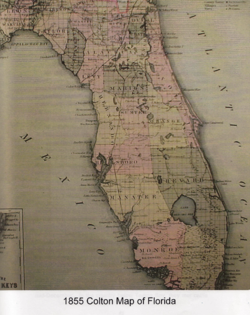
Indian River County is a county located in the Treasure Coast region of the U.S. state of Florida. As of the 2010 census, the population was 138,028. Its seat is Vero Beach. It is Florida's 7th richest county and in 2000 was the 87th richest county in the U.S. by per capita income.

Osceola County is a county located in the U.S. state of Florida. As of the 2010 census, the population was 268,685. Its county seat is Kissimmee.

St. Lucie County is a county in the U.S. state of Florida. As of the 2010 census, the population was 277,789. The county's seat is Fort Pierce. As of the 2015 Census Estimate, St. Lucie County has a population of 298,563.

Hobe Sound is an unincorporated area and census-designated place (CDP) in Martin County, Florida, United States. The population was 11,521 at the 2010 census.

East Florida was a colony of Great Britain from 1763 to 1783 and a province of Spanish Florida from 1783 to 1821. Consisting of peninsular Florida, East Florida was founded as a colony by the British colonial government in 1763, with its capital at St. Augustine, which had been the capital of Spanish La Florida.

Area code 407 is the area code centered principally on Orlando, Florida. It serves all of Orange, Osceola, and Seminole counties, as well as small portions of Volusia and Lake counties.

The Indian River Lagoon is a grouping of three lagoons: the Mosquito Lagoon, the Banana River, and the Indian River, on the Atlantic Coast of Florida; one of the most biodiverse estuaries in the Northern Hemisphere and is home to more than 4,300 species of plants and animals.

The Ais or Ays were a Native American people of eastern Florida. Their territory included coastal areas and islands from approximately Cape Canaveral to the Indian River. The Ais chiefdom consisted of a number of towns, each led by a chief who was subordinate to the paramount chief of Ais; the Indian River was known as the "River of Ais" to the Spanish. The Ais language has been linked to the Chitimacha language by linguist Julian Granberry, who points out that "Ais" means "the people" in the Chitimacha language.
George W. Hopkins was a lumberman involved in the removal of tens of thousands of acres of virgin forests in Michigan and Florida.

Mosquito County is the historic name of an early county that once comprised most of the eastern part of Florida. Its land included all of present-day Volusia, Brevard, Indian River, St. Lucie, Martin, Seminole, Osceola, Orange, Lake, Polk and Palm Beach counties.
Saint Lucia is an island country in the Caribbean.

Douglas Dummett (1806–1873) was a member of the Legislative Council of the Territory of Florida representing St. Johns County in 1843, and a member of the Florida House of Representatives representing Mosquito County in 1845. He was instrumental in developing the Indian River Citrus industry in Florida.
The History of Brevard County can be traced to the prehistory of native cultures living in the area from pre-Columbian times to the present age. Brevard County is a county in the U.S. state of Florida, along the coast of the Atlantic Ocean. The geographic boundaries of the county have changed significantly since its founding. The county is named for Judge Theodore W. Brevard, an early setter, and state comptroller. The official county seat has been located in Titusville since 1894, although most of the county's administration is performed from Viera.
William F. Russell was a Florida settler, soldier, and member of the Florida House of Representatives, serving as Speaker of the House in 1854. Russell was born in North Carolina. He became a major, and was put in charge of the Indian River Settlement in St. Lucia County, which broke up following an attack by Seminole Indians in July 1849. Russell was shot in the arm during the attack. Russell's brother-in-law John Barker was killed, but the rest of his family escaped to New Smyrna.

Mills Olcott Burnham was a Florida settler and member of the Florida House of Representatives from St. Lucia County.
John S. Heermans was a member of the Florida House of Representatives from St. Lucia County in the 1852 session, and after the county changed its name, from Brevard County in the sessions of 1856, 1858, and 1859. He had also served as a county commissioner for St. Lucia County in 1852. He served as a probate judge in 1851, and from 1853 to 1855.










